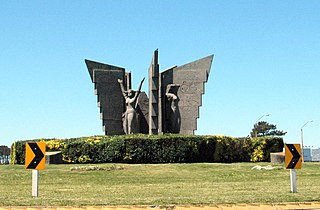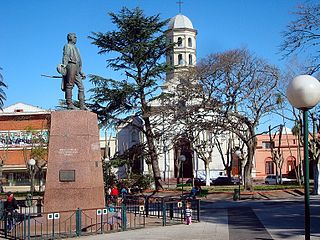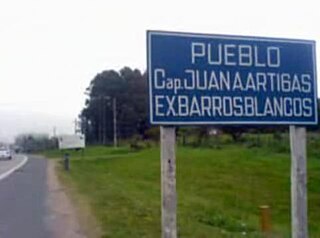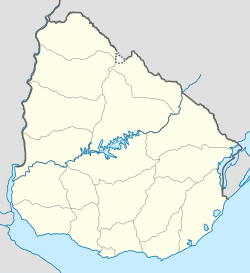
Canelones is the capital of the department of Canelones in Uruguay. Its name is derived from a species of cinnamon, which is called "canelón", growing along the banks of the homonymous river. Since 2010, the city is also the seat of the municipality of Canelones.
The Departamento de Canelones is one of the 19 Uruguayan departments. With an area of 4,536 km2 (1,751 sq mi) and 518,154 inhabitants, it is located in the south of Uruguay. Its capital is Canelones.

Las Piedras is a city in the Canelones Department of Uruguay. As of the census of 2011, it is the seventh most populated city of the country.

Tala is a town in the north of the Canelones Department of southern Uruguay.

Ciudad de la Costa is a city in Canelones Department of Uruguay, on the banks of the Río de la Plata between the streams Arroyo Carrasco and Arroyo Pando. It is considered an extension of the metropolitan area of Montevideo which it borders to the west, while to the east it borders Costa de Oro. It was declared a city on 19 October 1994 and given its current name. At the 2011 census, it was the second most populated city of Uruguay between Montevideo and Salto.

Pando is a city in the Canelones Department of Uruguay. It is an important commercial and industrial centre which has become part of the wider metropolitan area of Montevideo.
Toledo is a small city in the Canelones Department of Uruguay. Together with Villa Crespo y San Andrés, it forms a population centre of more than 14,000, which is also generally known as "Toledo", although the censual area of Toledo itself has only about 4,400 inhabitants, according to the 2011 census. They are both part of the wider metropitan area of Montevideo.

Santa Lucía is a city in the Canelones Department of southern Uruguay.

San Ramón is a small city in the north of Canelones Department, in southern Uruguay.

Barros Blancos is a city in the Canelones Department of southern Uruguay. In 1976, it had been renamed to Juan Antonio Artigas, after commanding officer Juan Antonio Artigas, grandfather of the national hero José Gervasio Artigas, but the old name was reinstated in 2007.

Joaquín Suárez is a village in the Canelones Department of southern Uruguay. It is at the intersection of Routes 84 and 74, northeast of Toledo and southwest of Pando. Sauce is about 10 kilometres (6.2 mi) to the north. The villages are all considered parts of the wider metropolitan area of Montevideo.
Dr. Francisco Soca or Soca is a small city in the Canelones Department of southern Uruguay.

Empalme Olmos is a village in the Canelones Department of southern Uruguay.
Migues is a small city in the Canelones Department of southern Uruguay.

Montes is a village in the east of Canelones Department of southern Uruguay.

Cerrillos or Los Cerrillos is a very small city in the west part of the Canelones Department of southern Uruguay.
San Bautista is a small city in the Canelones Department of southern Uruguay.

San Jacinto is a small city in the Canelones Department of southern Uruguay.
Santa Rosa is a small city in the Canelones Department of southern Uruguay.
Paso de Carrasco or Paso Carrasco is a city in the Canelones Department of Uruguay.

















